Lectrosonics DBu-LEMO Handleiding
Lectrosonics
Niet gecategoriseerd
DBu-LEMO
Bekijk gratis de handleiding van Lectrosonics DBu-LEMO (24 pagina’s), behorend tot de categorie Niet gecategoriseerd. Deze gids werd als nuttig beoordeeld door 44 mensen en kreeg gemiddeld 4.8 sterren uit 22.5 reviews. Heb je een vraag over Lectrosonics DBu-LEMO of wil je andere gebruikers van dit product iets vragen? Stel een vraag
Pagina 1/24

DBu
Digital Belt Pack Transmitter
DBu, DBu/E01
INSTRUCTION MANUAL
Rio Rancho, NM, USA
www.lectrosonics.com
Fill in for your records:
Serial Number:
Purchase Date:

DBu, DBu/E01
LECTROSONICS, INC.
2
Introduction
The DBu, DBu/E01 transmitter employs high efficiency
digital circuitry for extended operating time on two AA
batteries. The transmitter can tune in coarse or fine
steps across the UHF television band from 470.100 to
607.950 MHz (DBu/E01 frequency range is 470.100 to
614.375 MHz), with a selectable output power of 25 or
50 mW. The pure digital architecture enables AES 256-
CTR encryption for high level security applications.
Studio quality audio performance is assured by high
quality components in the preamp, wide range input
gain adjustment and DSP-controlled limiting. Input
connections and settings are included for any lavaliere
microphone, dynamic microphones and line level inputs.
Input gain is adjustable over a 44 dB range in 1 dB
steps to allow an exact match to the input signal level,
to maximize the dynamic range and signal to noise
ratio.
Frequency Agility
The transmitter tunes across the entire frequency
range, from 470.100 MHz to 607.950 MHz (DBu/E01
frequency range is 470.100 to 614.375 MHz).
Encryption
When transmitting audio, there are situations where
privacy is essential, such as during professional sport-
ing events, in court rooms or private meetings. For
instances where your audio transmission needs to be
kept secure, without sacrificing audio quality, Lectroson-
ics introduces Encryption Keys. Truly entropic encryp-
tion keys are first created by a Lectrosonics receiver,
such as the DSQD Receiver. The key is then synced
with the DBu, DBu/E01 via the IR port. The audio will
be encrypted and can only be listened to if both DBu,
DBu/E01and receiver have the matching encryption key.
If you are trying to transmit an audio signal and keys
do not match, all that will be heard is silence or white
noise.
Table of Contents
Introduction 2 ............................................................................
Frequency Agility..................................................................2
Encryption 2 ............................................................................
Servo Bias Input and Wiring 3 ................................................
DSP-controlled Input Limiter 3 ................................................
DBu, DBu/E01 Block Diagram 3 .............................................
Battery Installation 4 ................................................................
Battery Status LED Indicator 4 ...............................................
Belt Clips 5 ..............................................................................
IR (infrared) Port 5 ..................................................................
Features and Functions 5 ........................................................
Operating Instructions 6 ..........................................................
Powering On in Operating Mode 6 ..........................................
Powering On in Standby Mode 6 ............................................
Powering Off 6 ........................................................................
Power Menu Options 6 .............................................................
Entering the Power Menu 6 .....................................................
LCD Menu Map 7 .......................................................................
Main Menu and Setup Screen Details 8 ..................................
Entering the Main Menu 8 .......................................................
Main Window Indicators 8 ......................................................
Connecting the Signal Source 8 .............................................
Adjusting the Input Gain 8 .......................................................
Selecting Frequency 9 ............................................................
Selecting Programmable Switch Functions.......................... 9
Selecting the Low Frequency Roll-off 9 ..................................
Selecting Audio Polarity (Phase) 9 ..........................................
Selecting Battery Type ......................................................... 9
Setting Transmitter Output Power 9 ........................................
Remote 9 ................................................................................
Locking/Unlocking Changes to Settings............................... 10
Restoring Default Settings 10 ...................................................
KeyType 10 ...............................................................................
WipeKey 10 ...............................................................................
SendKey 10 ...............................................................................
LectroRM 11 ................................................................................
Whip Antennas 12 .....................................................................
Encryption Key and Settings Transfer 12 ................................
Accessories 13 ...........................................................................
5-Pin Input Jack Wiring 14 .........................................................
Microphone Cable Termination
for Non-Lectrosonics Microphones 15 ..............................
Input Jack Wiring for Different Sources 16 ..............................
Microphone RF Bypassing 17 ...................................................
Line Level Signals 17 ................................................................
Wireless Designer Software 18 ................................................
Firmware Update Instructions 18 ..............................................
Specifications 19 ........................................................................
Troubleshooting 20 .....................................................................
Service and Repair 21 ................................................................
Returning Units for Repair 21 ...................................................

Digital Belt-Pack Transmitter
Rio Rancho, NM 3
DBu, DBu/E01 Block Diagram
Filters
Keypad
(2) AA
Batteries
Oscillator
VCTXO
I2S I2S
Voltage Controlled
Oscillator
Final
AmplifierControl
PLL Ref Phase Locked Loop
DSP Clock
Switching
Power
Supply
Microprocessor
Power
LED
Tricolor
D-A Con -vert
er
A-D
Con rterve
Shunt
Limiter
Limiter Control
Gain
Adj
HI/Lo
Pass
Filter
Input
Preamp
Input
Jack
Bias Voltage
0, 2 or 4V
Ser Bias vo
Supply
+5V
I + Q
Baseband
Signals
Low
pass
filters
IQ Modulator
UART USB
Jack
Security yKe
Audio
Firmware
Update
Key Received
Blue LED
Low
Pass
Filter
Buffer
36.864 mHz
IR Port
Consumer Alert for US Users - FCC Order DA 10-92
Most users do not need a license to operate this wireless microphone system. Nevertheless, operating this microphone system
without a license is subject to certain restrictions: the system may not cause harmful interference; it must operate at a low power
level (not in excess of 50 milliwatts); and it has no protection from interference received from any other device. Purchasers
should also be aware that the FCC is currently evaluating use of wireless microphone systems, and these rules are subject to
change. For more information, call the FCC at 1-888- CALL-FCC (TTY: 1-888-TELL-FCC) or visit the FCC’s wireless microphone
website at www.fcc.gov/cgb/wirelessmicrophones. To operate wireless microphone systems at power greater than 50mW, you
must qualify as a Part 74 user and be licensed. If you qualify and wish to apply for a license go to: http://www.fcc.gov/Forms/
Form601/601.html
Servo Bias Input and Wiring
The DBu, DBu/E01 input preamp is a unique design
that delivers audible improvements over conventional
transmitter inputs, is easier to use and much harder to
overload. It is not necessary to introduce pads on some
mics to prevent overload of the input stage, divide the
bias voltage down for some low voltage mics, or reduce
the limiter range at minimum gain settings.
Two different microphone wiring schemes are available
to simplify and standardize the configuration. Simpli-
fied 2-wire and 3-wire configurations provide several
arrangements designed for use only with servo bias
inputs to take full advantage of the preamp circuitry.
Other wiring schemes are compatible with Servo Bias
and conventional inputs.
A line level input wiring provides an extended frequency
response with an LF roll-off at 35 Hz for use with instru-
ments and line level signal sources.
DSP-controlled Input Limiter
The transmitter employs a digitally-controlled analog
audio limiter prior to the analog-to-digital converter.
The limiter has a range greater than 30 dB for excellent
overload protection. A dual release envelope makes the
limiter acoustically transparent while maintaining low
distortion. It can be thought of as two limiters in series,
connected as a fast attack and release limiter followed
by a slow attack and release limiter. The limiter recovers
quickly from brief transients, so that its action is hidden
from the listener, but recovers slowly from sustained
high levels to keep audio distortion low and preserve
short term dynamic changes in the audio.
Product specificaties
| Merk: | Lectrosonics |
| Categorie: | Niet gecategoriseerd |
| Model: | DBu-LEMO |
Heb je hulp nodig?
Als je hulp nodig hebt met Lectrosonics DBu-LEMO stel dan hieronder een vraag en andere gebruikers zullen je antwoorden
Handleiding Niet gecategoriseerd Lectrosonics
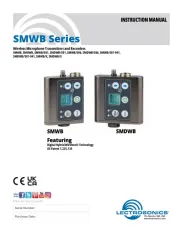
3 Maart 2025
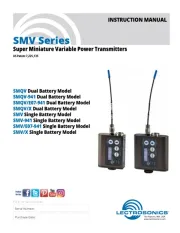
3 Maart 2025
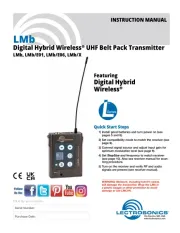
3 Maart 2025
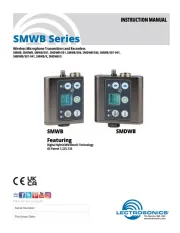
3 Maart 2025
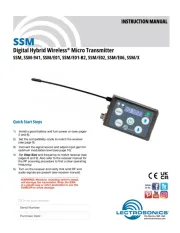
3 Maart 2025
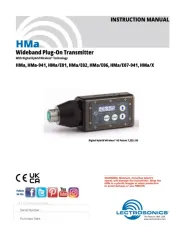
3 Maart 2025
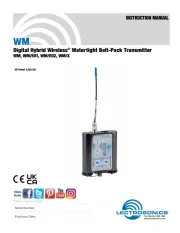
3 Maart 2025
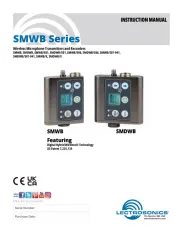
3 Maart 2025

3 Maart 2025

3 Maart 2025
Handleiding Niet gecategoriseerd
- CSFG
- Zeiss
- JLCooper
- Vitec
- BSS Audio
- West Elm
- Uvex
- Cyber Acoustics
- Schaffner
- Eoslift
- FitterFirst
- Simpson
- Soler & Palau
- Gastronoma
- Colortone
Nieuwste handleidingen voor Niet gecategoriseerd
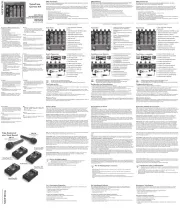
2 Augustus 2025
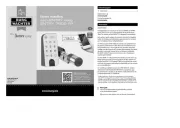
2 Augustus 2025
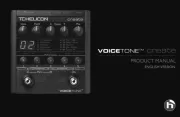
2 Augustus 2025
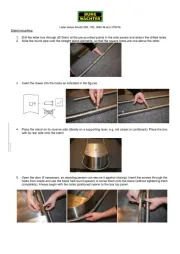
2 Augustus 2025
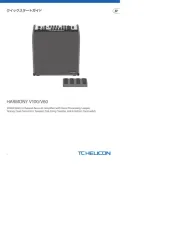
2 Augustus 2025
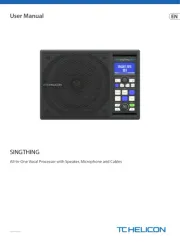
2 Augustus 2025
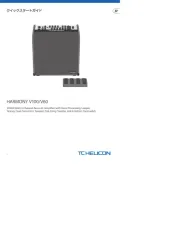
2 Augustus 2025
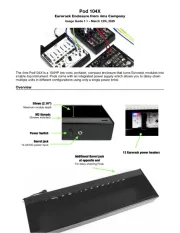
2 Augustus 2025

2 Augustus 2025
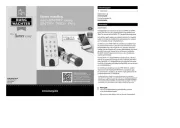
2 Augustus 2025